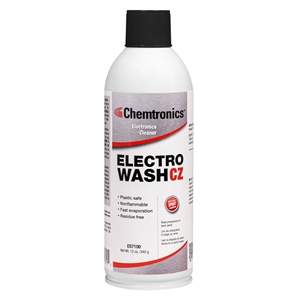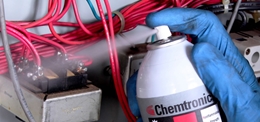Electro-Wash CZ Degreaser
Non-ozone depleting, nonflammable electronic cleaner and degreaser safe for use on plastics
Electro-Wash® CZ Cleaner Degreaser is an all purpose cleaner for electronics that is nonflammable, non-ozone depleting, and safe on plastics. This fast drying precision cleaner contains Chemtronics’ Cirozane™, which is based on HFE technology. It is excellent for removing grease, oil, and flux residues from energized equipment.
CIROZANE™ Cleaning Chemistry (CZ). Proprietary Solutions From Chemtronics.
Now, with CIROZANE CFC / HCFC Replacement chemistry, you won’t need to make any more undesirable trade-offs. CIROZANE-based products offer you a high performance, ultra-safe “drop-in” replacement to all CFC and HCFC chemistries.
CIROZANE chemistry is the result of an 18-month research effort. CIROZANE-based products offer all the performance of CFCs and HCFCs without any ozone depleting compounds.
CLICK HERE FOR CLEANER DEGREASER SELECTION GUIDE
Features & Benefits
- Safe on plastics; outstanding material compatibility
- Nonflammable
- Dries fast
- Leaves no residue
- Aerosol utilizes All-Way Spray valve; sprays in any direction
Applications
- Removes handling soils from live circuits
- Cleans oil and residue from sensitive surfaces
- Liquid can be used with ultrasonics, vapor degreasers, as a cold immersion solvent, or with spray dispensing system
| TDS | |
| REGS | |
| SDS | |
| Categories |
| Specifications | MIL-PRF-29608A (AS) Class C approved |
|---|---|
| NSN |
ES7100 - 6850-01-436-4584 ES7101 - 6850-01-436-4585 |
| Shelf Life | 5 yrs. |





